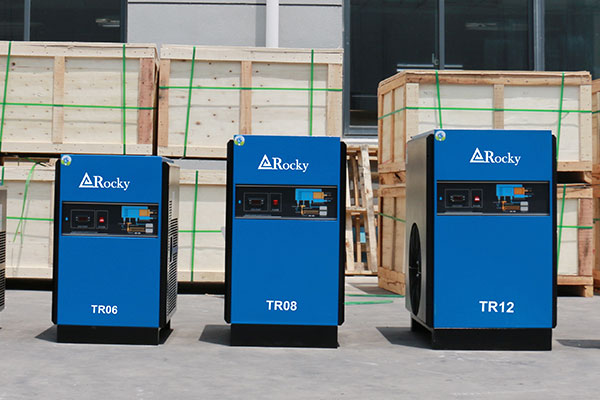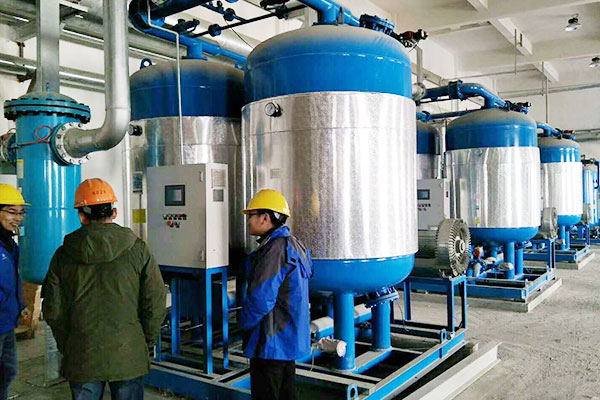During the use of the air compressor, if the machine malfunctions and then shuts down, the crew must vent the compressed air before inspecting or repairing the air compressor. To vent the compressed air, you need a post-processing equipment - a cold dryer or a suction dryer. Their full names are freeze dryers and adsorption dryers, which are essential post-processing equipment for air compressors. So, what is the difference between a cold dryer and a suction dryer? What are the advantages and disadvantages of each? Let’s take a look together.

1. Working principle
The cold dryer is based on the principle of refrigeration and dehumidification. It cools the saturated compressed air from the upstream to a certain dew point temperature through heat exchange with the refrigerant. At the same time, it condenses a large amount of liquid water, which is then separated by the gas-liquid separator and automatically discharged from the machine. In addition, the effect of water removal and drying is achieved; the suction dryer is based on the principle of pressure swing adsorption, so that the saturated compressed air from the upstream contacts the desiccant under a certain pressure, and adsorbs most of the moisture in the desiccant. The dried air enters the downstream work to achieve deep drying.
2. Water removal effect
The cold dryer is restricted by its own principle. If the temperature is too low, the machine will cause ice blockage, so the dew point temperature of the machine is usually maintained at 2~10℃; the suction dryer does not need to generate heat exchange through temperature changes, and the desiccant filled inside the machine can Deep drying, the dew point temperature of the outlet can reach below -20℃.
3. Energy loss
The cold dryer achieves the purpose of cooling through refrigerant compression, so it needs to be adapted to a higher power supply; the suction dryer only needs to control the valve through the electric control box, the power supply power is lower than the cold dryer, and the power loss is also less.
4. Gas volume loss
The cold dryer removes water by changing temperature, and the water generated during operation is discharged through the automatic drainer, so there is no loss of air volume; during the operation of the suction dryer, the desiccant placed in the machine needs to be regenerated after it is saturated with water, so it needs to be The regeneration gas loss is about 12-15%.
5. Energy loss
The cold dryer has three major systems: refrigerant, air, and electrical systems. The system components are relatively complex and the probability of failure is greater; the suction dryer is only likely to fail when the valves are frequently operated. Therefore, under normal circumstances, the failure rate of refrigerated dryers is higher than that of suction dryers.
What are the advantages and disadvantages of refrigerant air dryer?

Advantage
1. No compressed air consumption
Most users do not have very high requirements for the dew point of compressed air. Compared with suction dryers, using cold dryers saves more energy.
2. Daily maintenance is relatively simple
There is no valve wear, just clean the automatic drain filter on time.
3. Low operating noise
In the air compressor room, the operating noise of the refrigeration dryer is generally not heard.
4. The solid impurity content in the exhaust gas from the cold dryer is small.
In the air compressor room, the operating noise of the refrigeration dryer is generally not heard.
Disadvantages
The effective air supply volume of the cold dryer can reach 100%, but due to the restriction of the working principle, the minimum dew point of the air supply can only reach about 3℃; for every 5℃ increase in the inlet air temperature, the refrigeration efficiency will drop by 30%, and the supply The air dew point will also increase significantly and is greatly affected by the ambient temperature.
What are the advantages and disadvantages of desiccant air dryer?

Advantage
1. The dew point of compressed air can reach -70℃
2. Not affected by ambient temperature
3. Filtration effect and high impurity filtering
Disadvantages
1. There is compressed air consumption, which is easier to consume energy than a cold dryer.
2. Adsorbents need to be added and replaced regularly; valve parts are worn and require routine maintenance.
3. The suction dryer has the noise of decompression of the adsorption tower, and the operating noise is about 65 decibels.
The above is the difference between cold dryers and suction dryers and their respective advantages and disadvantages. Users can weigh the pros and cons based on the quality of compressed gas and cost of use, and equip a dryer corresponding to the air compressor.